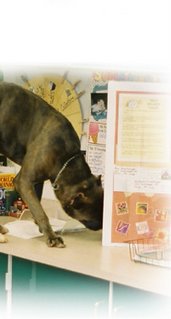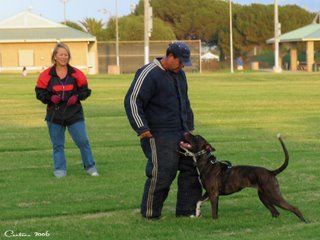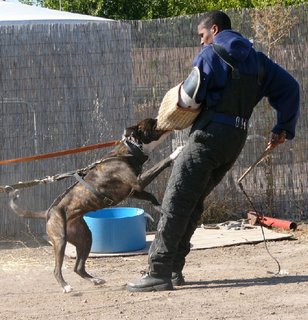
This is the Wikipedia Bandog article. Below the article is some input from Dan Balderson (DanUK) on the validity of the text.
Bandog (also known as Bandogge) is a name derived from early English and refers to a dog that was bound by a chain until it was released at night in order to guard property. The fact that the modern day Bandog is also large, is a guard dog, and is composed of some Mastiff and some Bulldog, as was the original Bandog, is all that the Bandog of old and the modern Bandog have in common.History of the bandog
Most writers are of the opinion that all dogs (Canis lupus familiaris) originated from the wolf (Canis lupus); however, the exact development of the original Bandogs still remains a mystery. Although, it is impossible to say exactly how the Bandog originated, it is certain the original Bandogs were bred with a functional purpose, as were all working breeds, and for the Bandog this purpose revolved around guarding and protecting. [citation needed]
Early incarnations of the Bandog probably had bloodlines from bull baiting dogs and the Guardian Mastiffs or the cross of both like the war dogs used in the Crusades.
William Harrison, in his description of England during 1586, first mentions the breed in his statement, "Bandogge which is a huge dog, stubborn, uglier, eager, burthenouse of bodie, terrible and fearful to behold and often more fierce and fell than any Archadian or Corsican cur." It is assumed that the word "Bandogge" originated from the use of strong bonds and chains to secure the dogs.[citation needed]
In 1576, Dr. Caius states that, among others characteristics, the "Mastiff or Bandogge is serviceable against the fox and the badger, to drive wild and tame swine out of meadows, and pastures, to bite and take the bull by the ears, when occasion so required."[citation needed]
The Bandogs of old were strictly working dogs, often of various crosses and various sizes. Usually these dogs were coarse-haired hunters, fighters and property protectors without a strictly set type, developed from eastern shepherds and mastiffs crossed with western Bullenbeissers and hounds, with a few local bloodlines eventually being established as specific types in some regions, such as Britain, Spain, Germany, Poland and elsewhere in Europe. One of the most famous Bandog programs in England led to the establishment of a recognized breed, the Bullmastiff.
Modern Breed Description
When describing Bandogs, it should be noted there have been many variations of such programs under a variety of names, but the breed commonly accepted as the Bandog today was developed in the 1960's by American veterinarian John Swinford, who set out to create a guardian dog superior to all others. Though many breeders of Bandogs today disagree on just what breeds went into Swinford's original breeding scheme, it has been proven that the basis of his program was largely derived from 50% American Pit Bull Terrier and 50% English Mastiff. Unfortunately, Swinford died in October of 1971 at an early age and his version of the Bandog, although very successful, was never perfected or recognized as a purebred during Swinford's time. Eventually, all the original Swinford dogs died out. .
—Dogwork 02:06, 13 October 2007 (UTC)Another notable developer of working class Bandogs is Joe Lucero. Lucero refers to his dogs as American Bandogge Mastiff. There are other bandog strains in existence under different names, but the Swinford and Lucero lines are the most famous celebrated for their stable temperaments and outstanding working qualities. Many people believe these dogs to be the perfect protection and working class guard dogs.
Many programs have used American Pit Bull Terrier (American Staffordshire Terrier) and Neapolitan Mastiff crosses, as has been the case with the Lucero program. Other programs, such as the Swinford program, developed primarily founded upon American Pit Bull Terrier and English Mastiff crosses. A few programs have also used other bully type breeds as well as other mastiff type breeds. Regardless however of which program a breeder selected, if they were breeding dogs true to guarding purposes it has been essential to select dogs suitable for such work. Dogs were bred from strains that have temperament, phenotype, to do home guardian or personal protection. The Bandog is a rugged dog, heavily boned and muscled, intimidating when seen and is ferocious when provoked. The Bandog, any variety, is strictly a working breed and should be a result of serious and dedicated planning, starting from careful selection of parent breeds and more importantly, appropriate representatives of those breeds, with the health and temperament testing being on the top of the list of priorities, while the uniformity in appearance is the last of the breeders' concerns. The intention in each case is to combine the courage and tenacity of an American Pit Bull Terrier with the large size and guarding instinct of a Mastiff.
Broad skull, strong muzzle that is medium to long muzzle depending on the strain, wide shoulder, powerful chest, great agility, intelligence and very well controlled dog.
Future
The hope is that the breeding of these dogs will finally be perfected; however, the Bandog is being bred by many breeders who range from the very serious and knowledgeable to the very amateurish and inexperienced, sometimes called backyard breeders. Like with all dogs, the Bandog can display either the best or the worst characteristics of the parents (or the parent breeds), depending on the knowledge of the breeder and the randomness of genetics. Therefore, a purchaser of a Bandog must do a good deal of investigation to avoid the risk of buying a puppy from a breeder that doesn't understand the necessity of proper selection.
[edit] Appearance
It should be noted that appearance is of least concern to serious bandog breeders, as the purpose of such dogs is first and foremost function. It should also be noted that not all groups currently agree on a universal standard. While some breeders share a general standard, the SSDA has kept their standard for the Swinford type dogs private and for this reason the general standard seen below will vary significantly from their adopted version.
Size: Males and females: Height: 25" or greater. Weight: 100 lbs or greater.
Drives: Natural guardian ability is required. The dog should display prey drive with enthusiasm. Defensive drive should be bold and confident when stimulated. Weakness in any form should be selected against.
Specials characteristic: Effectionate with the family, intelligent, loyal and devoted to their master.
Temperament: Effectionate, loving, and submissive to the master and family (including children), yet fearless adversary to anyone who threatens the Bandog's master or property. Although accepting to welcomed guests, the Bandog should present a guarding disposition towards visitors if his master is not at present.
Disposition: The Bandog protects their master against any danger, even to give their own life to protect him.
Body: Large, but compact. Powerful, but agile. Should represent an athlete.
Color: Different mixes of colors are acceptable, but most common colors are: any brindle color, black, golden fawn, fawn and red. Other colors are allowed too, as is red and black on their noses. Large amounts of white has been frowned upon by some programs due to its lack of being a natural color, inability to camouflage the dog well, and because it is often associated with various genetic defects.
Coat: Short, close and medium fine.
Ears: Cropped or natural.
Neck: Very strong, muscular and robust.
Eyes: Dark preferable, but should bear some relation to coat color.
Tail: Docked or natural.
Faults: Failure to be worked, failure to work successfully, producer of genetic problems in pups, poor immune system, affected by hip and elbow dysplasia. Excessively undershot.
Foundation Breeding
What is reported here is just an estimated expected average range of various foundations breeds commonly seen in various Bandog programs.
The Primary Group , approximate average of 25-75% from American Pit Bull Terrier and/or American Staffordshire Terrier.
The Secondary Group ,approximate average of 25-75% from Mastiff and/or Neapolitan Mastiff.
A Tertiary Group (used in some programs) approximate average of 0-75%: American Bulldog, Boerboel, Bullmastiff, Bulldog Campeiro, Bull Terrier, Cane Corso, Dogue de Bordeaux, Fila Brasileiro, Great Dane, Perro de Presa Canario, and/or the Tosa Inu.
http://en.wikipedia.org/wiki/BandogBelow by Dan Balderson:
The Wikipedia article still seems a bit off. Bandogges are mentioned by Geoffrey Chaucer over a 100 years before William Harrison wrote his works for example. Likewise, the Bandogge pre-dates the ‘sports’ of Bull baiting’ and such like. Bandogges pre-date the Normans, given that it was an Anglo Saxon term that eventually fell foul of the Norman (French) influence that led to the eventual word of ‘mastiff’. A wolfhound / Azores Griffon type dog was employed by the ‘Celts’ and was likely one of the forebears of the earliest Bandogge types. These dogs and the esteem with which they, along with boar and other key elements to that lifestyle are still seen today in the highly stylized forms of traditional ‘Celtic’ works of art, particularly as incorporated into knot work.
There is truth to the point of securing the dog, but the origins, at least as so far back as can be traced to Chaucer, suggest that Bandogge’s were in fact catch dogs that were kept tied whilst on the hunt until the game was in clear view / and at bay upon which time they were released, much akin to many modern hunters employing ‘Bulldogs’ today.
In terms of modern origin, the Bandog / Bandogge still originates from the British Empire; the term was used along with Game Keeper’s Night dog, Bull and Mastiff, and of course Bullmastiff with equal regularity until such time as an official breed was recognised under the latter term. However, Bandog, was also one of the proposed breed names (as they were regularly referred to as such in Print, certainly from around the 1930’s) at the time of acceptance and determination of a modern breed standard. The Bandogge concept was widely employed across the empire, notably in Southern Africa, but also in India where the term ‘Seizers’ came to the fore. These dogs were often mixes of English and German hounds with Bull, Mastiff and (Bull) Terrier breeds, or the latter combined with indigenous dogs, notably hounds such as the Rampur hound for the express purpose of big game hunting.
The Swinford stuff is also not wholly accurate. He worked with a great number of people to achieve his ends, of course Liebermann is known, but the likes of Grimm’s and a few others were equally involved, they simply chose not to gain the same degree of notoriety, nor had the exceptionally privileged background as to be able to conduct themselves as he did. His program was not entirely based on APBT to Neo, as Lee and others are correct to point out, that just happened to be at around the time he was most well-known prior to his death. His program was not successful or long lasting. Families such as the Grimm’s would encounter the American Bulldog and pursue it as everything the combined Swinford program was hoped to be, but was not. This point was even recorded in print when the family was interviewed about their involvement with both types of dog.
The current breeding section is a load of old tosh and frankly dangerously provocative “to combine the courage and tenacity of an American Pit Bull Terrier with the large size and guarding instinct of a Mastiff”. This is not strictly true and as such should not be presented in this context. It is a fallacy perpetuated by the limited and hence poor research of the author Carl Semenic whose primary research early on was gained during his exposure to the illicit world of dog fighting that existed and thrived in his region of the USA .
More accurately, the infusion of the Pitbull terrier is to correct the many structural, biological and temperamental flaws inherent in today’s mastiff breeds, to create a tighter, more functionally sound and active dog without the type of ‘tenacity’ that many folks would associate with the word when used in conjunction with the term ‘pitbull’ …it is not dog fighting aggression or tenacity …which is in many ways anathema to the purpose of a working mastiff. The Pitbull, when selected carefully, contributes a greater degree of bid ability and tolerance even, around people, creating a more fun-loving, less sharp, but very human-focused dog. Equally, inappropriate selection of the Pitbull can cause no end of problems; shyness, fearfulness (toward people) are inherent issues with some lines of these dogs, not specifically avoided because for other purposes (i.e. fighting) such traits were an acceptable hindrance, when they didn’t otherwise impede performance in the illicit world of dog fighting. It is also true that the Pitbull is far from the only breed used or necessary to be used in the development of Bandogs. Staffordshire Bull Terriers are equally employed, though do not produce the same degree of size in the F1 progeny as many lines of Pitbull might, but still develop the same positive qualities. Indeed, the Stafford is documented as having been used in the re(-construction) of the Perro de Presa Canario among other breeds. In sport/pp working bandogs, AmStaff blood is also heavily employed, in part because these dogs are not only bigger, but because many lines have already been bred to perform in avenues such as Schutzhunde for many generations. In animal catching Bandogges, both English Bull Terrier and American Bulldog have also been employed, in particular in regions such as Australia where non-indigenous hogs have reached epidemic proportions and are otherwise prey only to the Saltwater Crocodile once mature.
Not only is the assertion that “why don't breeders simply cross Bandogs with other Bandogs. The answer is at the current stage of Bandog development, when one crosses a Bandog with another of its breed, the final product is not a Bandog. Bandogs do not breed true yet and it seems that Bandog breeders are far from having perfected a purebred dog.” Yet another poor attempt at research by drawing upon the opinion of a frankly unqualified author such as Semenic, it is patently false and in keeping with the ignorance presented prior; the Bandog is most often a tight mastiff/bull mastiff not a large pitbull (petbull/pulldog). The primary breeding practice in the initial generations is to backcross the first filial generation to the mastiff component of the breed, rather than to another F1 or the parent bull & terrier; because again, the effort is to produce a balanced, functional working mastiff, not a large pitbull. This is exactly the same type of process employed in the creation of all breeds and is no different in bandogs. The primary differentiator is the employment of traditional, rather than modern Kennel Club breeding practices that do not preclude selective line and even out-crossing to maintain both performance and health, even if it does sacrifice a degree of type.
I really don’t like the use of the word aggressive in the piece either, it is thrown around without care or attention to the readership, or the effects it might have upon them. In short and without wanting to sound too callous, critical or offensive, it is quite an amateurish piece in many regards when actually scrutinised, and I find it to be lacking. However, having seen the pieces on other breeds, such as the Presa Canario, which I’m reliably told is petitioned regularly by Dogo Canario breeders to ensure it states a view akin with their beliefs, this is one area in which Wikipedia falls down, given a lack of quality references to support submissions.























































